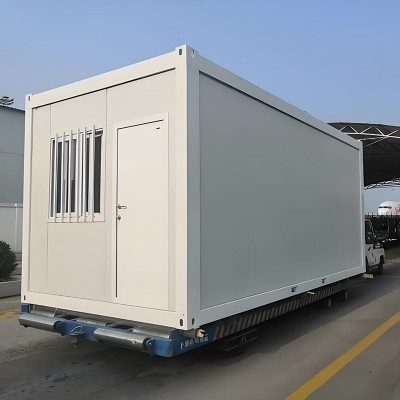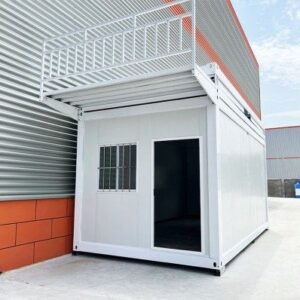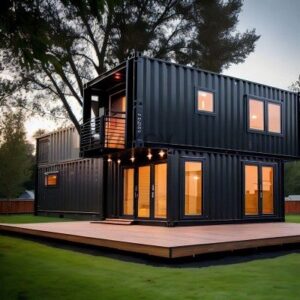Thinking about building a shipping container house but wondering, how much a shipping container house cost? You’re not alone. As more people seek affordable, eco-friendly housing alternatives, understanding the real expenses behind container homes is crucial before you dive in. From container prices to customization, permits, and finishing touches, the costs can vary widely—knowing what to expect saves you time and money. In this guide, I’ll break down exactly what impacts your budget and how to plan realistically for your container house project. Let’s get you the straight facts so you can make smart, confident decisions!
Overview of Shipping Container Houses
Shipping container houses have become an increasingly popular alternative to traditional homes across the United States, thanks to their affordable prices, modular design, and eco-friendly features. Understanding the types and common uses of these homes is essential when considering the cost to build a shipping container house.
Types of Shipping Container Homes
Shipping container homes come in various styles, ranging from single container units to multi-container configurations and luxury models:
- Single Container HomesTypically built from a single 20ft or 40ft container, these compact homes are ideal for tiny house enthusiasts, mobile living, or backyard guest houses. They offer a cost-effective entry point into container living while maintaining functionality.
- Multi-Container HomesCombining two or more containers, these homes create larger, more customizable living spaces. Multi-container designs allow for open floor plans, multiple bedrooms, and added amenities, appealing to families or those seeking more room.
- Luxury Container HomesHigh-end models incorporate multiple containers with premium finishes, sophisticated architecture, and advanced sustainability features. These homes rival traditional houses in comfort and style, often featuring smart home integrations and eco-friendly systems.
Common Uses of Shipping Container Houses
The flexibility of container homes supports a broad range of applications, including:
- Affordable HousingAs a solution to rising housing costs, container homes provide affordable, quick-to-build options for individuals and families needing budget-friendly residences.
- Eco-Friendly HomesShipping containers are repurposed steel structures, making container houses a sustainable housing choice. Many designs integrate solar panels, rainwater collection, and energy-efficient insulation.
- Mobile HousingDue to their original purpose and durable structure, container homes can be relocated if necessary, suitable for mobile lifestyles or temporary housing needs.
- Offices and WorkspacesContainers offer sturdy, customizable shells that can be converted into home offices, studios, or commercial spaces, ideal for remote work or small businesses.
Factors That Influence the Cost of a Shipping Container House
When figuring out the shipping container home price or the cost to build a container house, several key elements come into play. Understanding these factors helps set realistic expectations and manage your shipping container house budget effectively.
Size and Number of Containers
- The bigger the home, the higher the cost. A single 20ft container is cheaper than combining multiple containers to build a larger, more complex structure.
- More containers mean more structural work, welding, and finishing.
New vs Used Containers
- New containers cost more upfront but require less repair and modification.
- Used containers are cheaper but might need extra work to fix rust, dents, or contamination—raising overall costs.
Design Complexity and Customization
- Simple, boxy designs keep costs down.
- Complex layouts, custom windows, doors, and special architectural features increase design and construction expenses.
Location and Site Preparation Costs
- Costs vary by region depending on land topography, accessibility, and local labor rates.
- Preparing the site—leveling, foundation work, drainage—adds to the budget, especially for rough terrain.
Permits Regulations and Local Building Codes
- Permits can significantly add to your price.
- Some areas have strict codes that require additional modifications, inspections, and paperwork.
Transportation and Delivery Fees
- Shipping containers must be transported from the port or supplier to your site.
- Distance, truck size, permits for oversized loads, and special delivery conditions can affect the cost here.
Labor Costs DIY vs Professional Contractors
- Doing parts of the build yourself cuts costs but requires skills and time.
- Hiring pros ensures quality work but increases labor expenses.
Insulation Ventilation and HVAC Systems
- Proper insulation is critical for comfort and energy efficiency, and can be pricey.
- Ventilation and heating/cooling systems need to be planned and installed correctly, adding to the budget.
Interior Fittings and Finishing
- Plumbing, electrical wiring, drywall, flooring, and wall finishes vary widely in cost depending on materials and quality.
- Kitchens and bathrooms are often the most expensive interior areas to build out.
Sustainability Features and Off Grid Capabilities
- Adding solar panels, rainwater systems, or composting toilets can increase initial costs but save money over time.
- Off-grid setups require careful planning and can raise upfront investments.
For a complete look at how these factors affect pricing and further details on building container homes, check out our guide on how much cost a container house. Also, see tips on how to build a shipping container house for practical insight into reducing costs while planning your home.
Shipping Container House Cost Breakdown
Understanding the typical cost breakdown helps you plan your shipping container house budget clearly. Here’s what usually goes into the overall price:
Base Container Price
- Price per container varies depending on size and condition.
- A new 40ft container can cost between $3,000 and $5,000, while used ones might be around $1,500 to $3,000.
- Smaller 20ft containers are cheaper but offer less space.
Modifications and Structural Work
- Cutting openings for doors, windows, and reinforcing the container for structural integrity can add $10,000 to $25,000 or more depending on complexity.
- Includes welding, steel framing, and making the structure safe and durable for living.
Foundation and Site Work
- The foundation type—concrete slab, pier, or gravel pad—affects cost.
- Site prep like leveling, drainage, and accessibility may add $5,000 to $15,000 depending on your location and terrain.
Interior Finishing and Utilities
- Installing insulation, drywall, flooring, plumbing, and electrical systems typically ranges from $15,000 to $30,000.
- HVAC installation or ventilation systems are included here to keep your home comfortable.
- Kitchen and bathroom fixtures also impact this part of the budget.
Additional Features and Upgrades
- Adding solar panels, smart home technologies, or custom landscaping can increase the total by $5,000 to $20,000+ depending on your goals.
- Green features or off-grid capabilities fall under this category too.
Contingency and Unforeseen Costs
- Always plan for about 10-15% extra for unexpected expenses like permit delays, material price changes, or design adjustments.
Estimated Price Ranges for Shipping Container Houses
When it comes to shipping container home prices, costs can vary widely depending on size, design, and customization. Here’s a clear breakdown to help you understand what to expect:
Budget Options Basic Models $10,000 to $30,000
These are simple setups, often using a single used container with minimal modifications. They usually include basic insulation, flooring, and essential utilities. Ideal if you want an affordable starter home or a small mobile office. Keep in mind, these won’t include luxury finishes or extensive customization but offer a solid option for affordable container homes.
Mid Range Homes Moderate Customization $40,000 to $80,000
Mid-tier container houses often combine multiple containers or have more complex layouts. You get better insulation, upgraded plumbing and electrical, plus some interior finishing like drywall, better flooring, and cabinetry. This price range fits well for those seeking a comfortable, efficient home without going full luxury. Most customers looking for balanced comfort and cost fall here.
High End Container Homes Luxury Multiple Containers $80,000 to $150,000+
At this level, you’re looking at custom designs with several containers joined together or prefabricated luxury modules. Expect top-tier finishes, smart home features, solar power, off-grid capabilities, and extensive site work. These homes focus on architectural elegance, sustainability, and maximum comfort, pushing costs higher but delivering a unique lifestyle.

Regional Cost Variations and Why Location Matters
Location plays a big role in your total container house budget. In the U.S., shipping container house construction costs can change based on:
- Local building codes and permit fees
- Labor rates (higher in urban or high-demand areas)
- Site preparation challenges like terrain or soil type
- Transportation and delivery costs depending on distance from the container supplier
- Weather considerations that affect insulation and HVAC needs
For example, building in rural Texas may be cheaper than in California or New York due to different regulations and labor costs. Always factor in these regional differences to create a realistic budget.
For more details on cost and container types, check out how much does a shipping container house cost and explore options for a 20ft container house to suit your needs.
Tips to Save on Shipping Container House Costs
Building a shipping container house can get pricey, but you can cut expenses without sacrificing quality. Here are practical ways to save on your shipping container house budget while keeping the project on track.
Choose Used Containers Wisely
Using used shipping containers is often the quickest way to save on upfront costs. But don’t rush to pick any container—inspect for rust, structural damage, and hazardous materials. Containers in good condition reduce costly repairs and modifications later on. Buying from local suppliers can also cut transportation fees.
Design Efficiently to Minimize Modifications
Complex designs and heavy customizations drive up your container house construction cost. To keep expenses low:
- Stick to simple, modular layouts that fit container dimensions
- Avoid excessive cutting or welding that requires structural reinforcements
- Plan multi-use spaces to maximize square footage without adding containers
Efficiency here means fewer surprises and less labor time.
Leverage Local Materials and Labor
Using locally sourced materials for insulation, interior finishes, and utilities helps trim shipping and delivery fees. Plus, hiring local contractors familiar with regional building codes can prevent costly delays and rework. Ask about suppliers or subcontractors who work nearby to reduce overall project expenses.
Use a Phased Construction Approach
Breaking your project into smaller phases lets you manage cash flow and adjust your budget as you go. Start with essentials—foundation, framing, basic utilities—then add interior finishes or sustainability features over time. This approach also gives you room to learn and adapt without overspending upfront.
Financing and Budgeting for Your Shipping Container House
When planning the cost to build a container house, having a solid financing and budgeting strategy is crucial. Unlike traditional homes, container homes often require different loan options and thoughtful budget planning to cover unique expenses.
Loan Options and Mortgage Considerations
Financing a shipping container home isn’t always straightforward with conventional mortgages because many lenders treat container homes like RVs or tiny houses. However, you have these options:
- Construction Loans: Some lenders offer loans specifically for building container homes, often requiring detailed plans and permits.
- Personal Loans: For smaller container house projects, personal loans with flexible terms can work.
- FHA and VA Loans: These generally do not cover container homes unless they meet specific criteria and are permanently fixed to land.
- Home Equity Loans and Lines of Credit: If you own property, these can provide funds for your container house construction or purchase.
- Specialty Lenders: Some companies specialize in financing alternative homes, including prefab and modular container homes.
Tip: Always check with local lenders about their policies on shipping container homes since availability varies by region.
Cost Comparison with Traditional Houses
Container homes often cost less upfront than traditional houses, but budget wisely for these differences:
| Aspect | Shipping Container Home | Traditional House |
|---|---|---|
| Base Construction Cost | $10,000–$30,000 for a basic container | $150–$250 per sq. ft. on average |
| Customization and Modifications | Can increase cost by 50%+ | Usually included in initial contract |
| Permits and Regulations | Can be less predictable and variable | Generally well-defined |
| Financing Options | More limited and specialized | Widely available and standardized |
| Construction Timeline | Often shorter due to prefab nature | Longer due to traditional building methods |
Creating a Realistic Detailed Budget
A successful container house budget should be comprehensive and flexible. Here’s what to include:
- Base Container Price: Know whether buying new or used containers fits your budget.
- Modifications and Upgrades: Factor in cutting, welding, insulation, and windows.
- Site Preparation Cost: Land clearing, foundation work, and access roads may add up.
- Permits and Inspections: Always budget for local building permits and necessary inspections.
- Utilities and Interior Finishing: Plumbing, electrical, HVAC, flooring, and fixtures.
- Professional Labor vs DIY: Skilled labor adds costs but ensures code compliance and quality.
- Contingency Fund: Set aside at least 10-15% of your budget for unexpected expenses.
Tracking expenses as you go and updating your budget regularly can save you from surprises. Using budgeting apps or spreadsheets dedicated to container homes can help keep spending on track.
In , financing a shipping container home requires knowing your loan options, understanding how costs compare with traditional houses, and building a detailed budget that covers every stage from container purchase to finishing touches. This approach helps you manage your shipping container house construction cost effectively and achieve your dream home without financial stress.
Common Costly Mistakes in Shipping Container House Cost and How to Avoid Them
When planning your shipping container house budget, some mistakes can quickly blow up costs. Being aware of these pitfalls can save you time, money, and frustration.
Underestimating Permits and Regulatory Costs
A lot of people overlook local permits and building codes. These aren’t optional, and ignoring them can cause delays or fines.
- Always check local zoning laws early. Regulations vary widely by state and city.
- Factor permit fees, inspections, and possible site adjustments into your budget.
- Remember, some areas require engineered plans for container homes, which adds to design costs.
Ignoring Insulation and Weatherproofing Expenses
Shipping containers are steel boxes, so they heat up and cool down fast. Skimping on insulation or weatherproofing can lead to high energy bills and uncomfortable living conditions.
- Budget properly for quality insulation—spray foam or rigid boards are common choices.
- Include ventilation and moisture barriers to avoid rust and mold issues.
- Don’t overlook windows and doors that help regulate the temperature while maintaining durability.
Skimping on Professional Advice and Inspections
Trying to cut costs by avoiding experts might backfire with costly fixes down the road.
- Hire experienced architects or engineers familiar with container modifications.
- Use professional inspections to spot structural or safety issues early.
- Skilled contractors familiar with container homes can work efficiently, potentially saving money despite higher upfront costs.
Why Choose Yichen for Your Shipping Container House Needs
When it comes to shipping container house cost and customized solutions, Yichen stands out for expertise and dependable customer service tailored to the U.S. market. Whether you’re budgeting for a single container home or planning a luxury multi-container model, Yichen delivers a smooth, hassle-free experience from design to installation.
Proven Expertise and Custom Solutions
- Experienced team with extensive knowledge of container home design, local building codes, and cost factors affecting container house construction.
- Offers customized plans to fit your budget whether you seek affordable options or high-end finishes.
- Focus on energy-efficient and eco-friendly homes, helping you save on long-term utilities and support sustainable living.
- Provides full service: container sourcing, modification, site prep, and installation — making the process easier and more predictable.
Outstanding Customer Service
- Responsive support that walks you through the entire journey, from initial quote to final inspection.
- Transparent cost breakdowns and financing advice help you plan realistically and avoid surprises on your shipping container house budget.
- Reviews mention quick turnaround times, quality craftsmanship, and professional communication.
Real Case Examples
- Multiple projects nationwide demonstrating success in affordable container homes for remote areas, urban mobile offices, and luxury retreat designs.
- Clients praised Yichen for managing complex shipping container home construction costs efficiently, keeping projects on schedule and within budget.
With Yichen, you get a partner focused on your vision and bottom-line, delivering value and quality in the growing U.S. market for how much a shipping container house cost and construction costs



